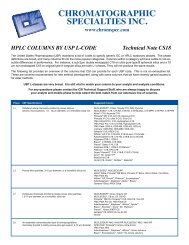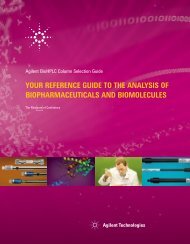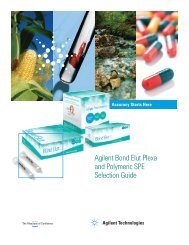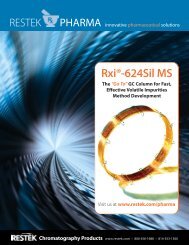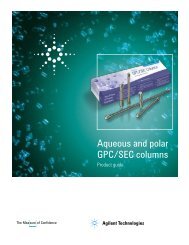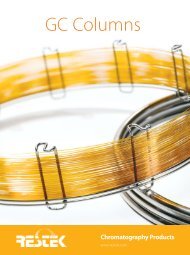Optimizing the Analysis of Volatile Organic Compounds
Optimizing the Analysis of Volatile Organic Compounds
Optimizing the Analysis of Volatile Organic Compounds
You also want an ePaper? Increase the reach of your titles
YUMPU automatically turns print PDFs into web optimized ePapers that Google loves.
18<br />
Vu-Tight ® Direct Injection Liner<br />
Visually observe <strong>the</strong> Press-<br />
Tight ® connection between<br />
<strong>the</strong> column end and liner.<br />
1/4-Inch OD: accepts 0.32<br />
or 0.53mm ID capillary<br />
column (column OD from<br />
0.5mm to 0.8mm).<br />
Slotted top prevents obstruction<br />
<strong>of</strong> carrier gas flow.<br />
Two designs available.*<br />
Operate in <strong>the</strong> direct injection mode.<br />
Can easily be packed with wool for<br />
dirty samples.<br />
Description qty. cat.#<br />
Vu-Tight ® DI Liner ea. 20342<br />
Vu-Tight ® DI Liner 5-pk. 20343<br />
Vu-Tight ® DI Liner 25-pk. 20344<br />
* Refer to our catalog for information about<br />
Cyclo Vu-Tight ® liners, for use with dirty<br />
samples.<br />
www.restekcorp.com<br />
GC System Configurations<br />
Wide-bore Systems (0.45mm ID and 0.53mm ID columns)<br />
Wide-bore capillary columns are operated at faster flow rates than narrow-bore columns, and<br />
can be connected directly to <strong>the</strong> purge and trap system with a 10mL/min. desorb flow. Widebore<br />
columns used for VOCs analyses usually are coated with a thick film <strong>of</strong> stationary<br />
phase to increase retention and separation <strong>of</strong> <strong>the</strong> highly volatile analytes (e.g.,<br />
chloromethane and vinyl chloride, bromomethane and chloroethane), or o<strong>the</strong>r closely-eluting<br />
sample components.<br />
Wide-bore columns range from 30-105 meters in length. A longer column can refocus earlyeluting<br />
volatile compounds and greatly improve separation <strong>of</strong> <strong>the</strong> gases (see Applications,<br />
page 37). Shorter columns require sub-ambient cooling for separating <strong>the</strong> gases; this increases<br />
<strong>the</strong> cost <strong>of</strong> <strong>the</strong> analysis and adds laboratory time associated with handling tanks <strong>of</strong> liquid<br />
nitrogen. For best overall results, we recommend using a 75m, 0.45mm ID capillary column<br />
for analyzing <strong>the</strong> volatile compounds listed in US EPA Methods 502.2 and 8021B (see<br />
Applications, page 37).<br />
Resolution <strong>of</strong> <strong>the</strong> early-eluting gaseous analytes increases significantly with a decrease in<br />
temperature. Use a starting temperature <strong>of</strong> 35°C-50°C, depending on <strong>the</strong> target list and <strong>the</strong><br />
purge and trap conditions (see Applications, page 37). A longer column can be used to<br />
increase <strong>the</strong> pressure within <strong>the</strong> column, which, in turn, will increase <strong>the</strong> solubility <strong>of</strong> <strong>the</strong><br />
analytes in <strong>the</strong> stationary phase. Using optimized temperature programs and narrower bandwidths,<br />
reasonably fast analysis times can be achieved (see page 37). However, <strong>the</strong> higher<br />
flow rates through wide-bore columns prevent <strong>the</strong> analyst from directly connecting <strong>the</strong> column<br />
to <strong>the</strong> vacuum system <strong>of</strong> an MS. A jet separator or open split interface must be used to<br />
reduce <strong>the</strong> amount <strong>of</strong> carrier gas flowing into <strong>the</strong> MS (see Figure 31, page 32).<br />
The method for connecting a purge and trap transfer line to a wide-bore GC column should<br />
be carefully considered. The three connection methods are: 1) through <strong>the</strong> existing GC injection<br />
port; 2) using a low volume injector; and 3) with a direct column connection. These<br />
alternatives are described below.<br />
Injection Port Connection: In this connection option, <strong>the</strong> purge and trap transfer line is connected<br />
to <strong>the</strong> GC injection port that accepts <strong>the</strong> carrier gas line. The carrier gas line is cut<br />
close to <strong>the</strong> injection port body and a deactivated union (e.g., cat.# 20510, see our catalog) is<br />
used to connect <strong>the</strong> purge and trap transfer line to <strong>the</strong> injection port (Figures 13 through 16).<br />
This allows <strong>the</strong> analyst to make manual injections when troubleshooting, and to inject brom<strong>of</strong>luorobenzene<br />
when tuning <strong>the</strong> MS in accordance with EPA methods. The injection port<br />
can be a source <strong>of</strong> dead volume, however. Dead volume causes band broadening, resulting in<br />
poor peak shape and loss <strong>of</strong> resolution for <strong>the</strong> most volatile target compounds. The severity<br />
<strong>of</strong> <strong>the</strong> problem is determined by <strong>the</strong> inside diameter <strong>of</strong> <strong>the</strong> injection port liner and <strong>the</strong> total<br />
desorb flow through <strong>the</strong> port. To reduce <strong>the</strong> dead volume in <strong>the</strong> injection port, use a 1mm ID<br />
split liner (e.g., cat. #20972; see products section). If <strong>the</strong> injection port is designed for<br />
Figure 13.<br />
Plumbing a purge and trap interface to a GC injection port allows flow adjustment via <strong>the</strong><br />
GC flow controller. This is <strong>the</strong> most common way <strong>of</strong> analyzing volatile compounds by MS<br />
because <strong>the</strong> flow can be split, allowing 1mL/min. into <strong>the</strong> MS source.<br />
Septum Purge Line<br />
Line From P&T<br />
Split Line





